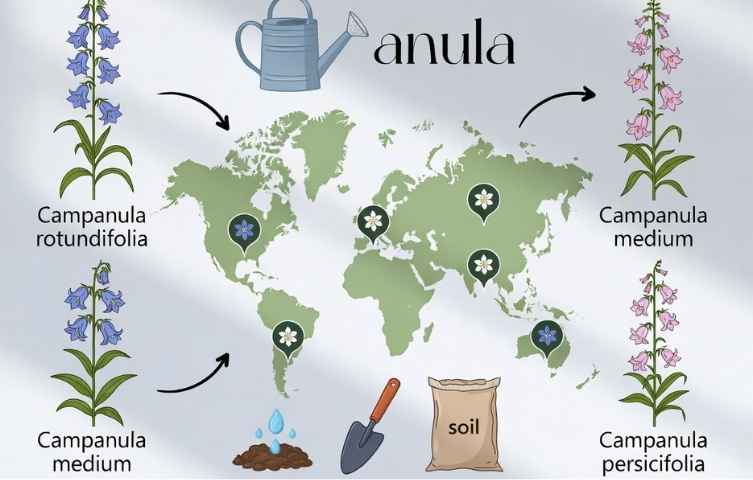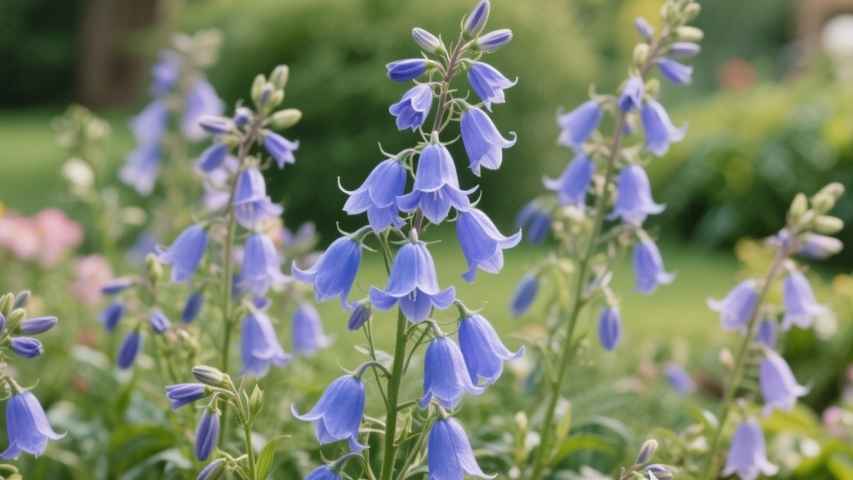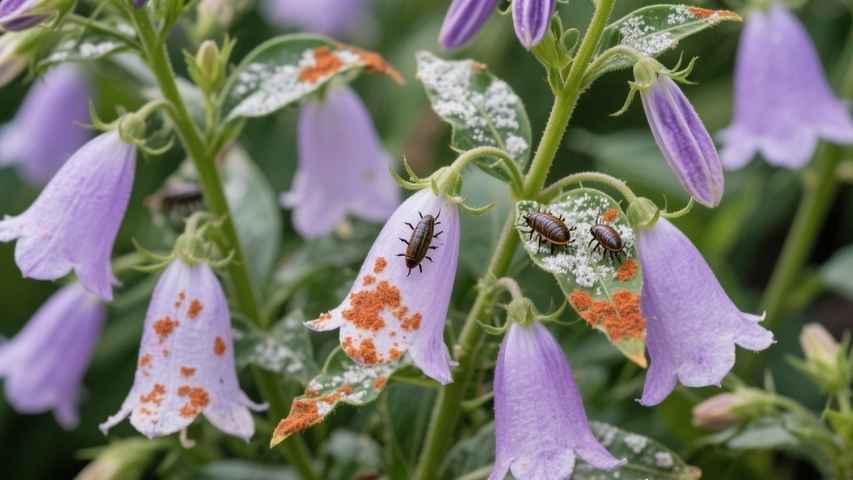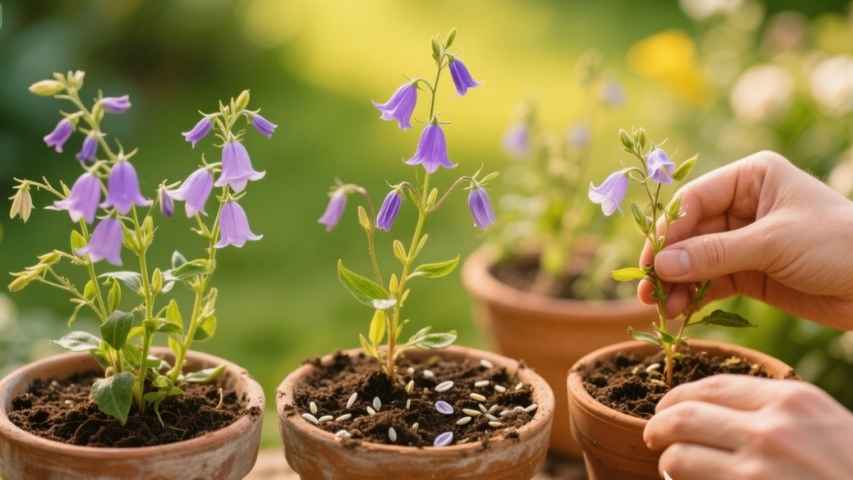Bellflowers are easy to care for and bring long-lasting, bell-shaped blooms to your garden, including the rare blue flower. They come in many sizes and shapes, making them a great fit for cottage-style gardens.
This guide covers all the basics for growing bellflowers. Whether you choose small alpine types or tall woodland varieties, most have the classic five-petaled bloom. Some flowers face up, while others hang in clusters. They bloom for weeks from late spring to summer, mostly in blue and purple, but also in white and pink.
Where to Plant Bellflower

Because bellflowers are such a diverse group of plants, it’s essential to research the specific variety you choose before planting. They are native to many different geographic regions, so what works for one type might not be ideal for another. However, there are some general guidelines for successful planting.
Soil Requirements
Most bellflowers do best in well-drained soil. Some can handle moist spots, but many small alpine types like very fast-draining soil. These tough plants can even grow well in rock walls or trough gardens.
Light Conditions
To get the most flowers, plant bellflowers in full sun. Some woodland types can grow in part or full shade, but plenty of sunlight helps taller plants stay upright without needing stakes.
Potential Invasiveness
Be aware that many campanula species spread not only by seed but also through underground rhizomes, which can make them invasive. Creeping bellflower (Campanula rapunculoides), for instance, is considered an invasive species in several parts of North America. Always check with local agencies before planting, as established bellflowers can be difficult to remove.
How and When to Plant Bellflowers

Plant bellflowers in spring after the last frost, though some types can also go in the ground in fall. Plant on a cloudy day or in late afternoon to help the plants adjust more easily.
Loosen the soil to a depth of 6 to 12 inches and clear out any debris. Add compost or manure if the soil needs a boost. Dig a hole a bit bigger than the plant’s roots and set the plant in so the roots are level with the ground. Fill in the hole, press the soil down gently, and water well. Add mulch around the base to keep the soil moist.
Bellflower Care Tips

Bellflowers are easy to care for and usually don’t have major pest problems, so they’re a great choice for new gardeners.
Light
Most bellflowers perform best in full sun, which is especially important for keeping taller varieties standing upright without stakes. Always check the plant label for specific light requirements for your chosen variety.
Soil and Water
While most bellflowers need well-drained soil, some alpine species, like Campanula saxifraga, require very sharply drained conditions, allowing them to grow in unique spots like rock walls. Soil pH needs vary, but most do well in neutral soil.
After planting, water bellflowers often enough to keep the soil moist about an inch deep. Early morning is the best time to water.
Temperature and Humidity
Bellflowers do best where days are warm and nights are cool. Some types may not do well if nights stay above 70°F, especially if it’s humid. In hot areas, try planting them in partial sun instead of full sun.
Fertilizer
In the early spring, when the plant begins to grow, apply a balanced 10-10-10 fertiliser. If you’re using a granular formula, be sure to keep it away from the plant’s leaves and crown to avoid burning it.
Pruning
Removing old flowers, called deadheading, can help some bellflowers bloom more. Take off each spent bloom carefully so you don’t harm new buds. For some types, don’t deadhead after the first round of flowers, since more will come on their own. As summer goes on, trim any leaves that look worn out.
Common Pests and Problems

Bellflowers usually don’t have many pest problems, but sometimes aphids, slugs, snails, or spider mites can show up.
Rust and powdery mildew are two fungal diseases that can affect bellflowers, especially in damp conditions. Rust appears as light-colored spots on leaves with reddish-orange pustules on the undersides. Powdery mildew looks like a white or grey powder on the foliage. To prevent these diseases, water plants at the base and ensure proper spacing for good air circulation. If you see infected leaves, remove and destroy them to prevent the disease from spreading.
How to Propagate Bellflowers

How you propagate bellflowers depends on the type, so check what works for your variety. The main ways are by seed, division, or stem cuttings.
Seed
Some bellflowers reseed on their own. If you’re starting perennial bellflowers from seed, keep in mind they won’t bloom until their second year. Sow seeds indoors 8 to 10 weeks before your last frost date. Keep the soil moist and warm (65-70°F), and seedlings should appear in 20 to 30 days. To sow directly outdoors, wait until after the frost danger has passed. Some seeds may require cold stratification, meaning they need to be planted outside in the winter.
Division
Divide bellflowers every two to five years to keep them healthy and control their spread. Do this in the fall, four to six weeks before the first frost. Water the plant the day before. Gently dig it up, making sure to get all the roots, and split it into smaller pieces, each with roots and new shoots. Replant the new sections right away.
Stem Cuttings
To propagate from stem cuttings, take 4-inch cuttings from young growth in the spring for summer bloomers, or in the summer/fall for spring bloomers. Remove the lower leaves, dip the stem in growth hormone, and plant it in a pot with a growing medium. Cover the pot with plastic, place it in a warm, well-lit area, and keep the soil moist. Once rooted, the plastic can be removed.
A More Beautiful Garden
Bellflowers are easy to grow and add lovely, bell-shaped blooms to any garden. If you meet their basic needs for sun, water, and soil, you’ll enjoy their bright colors year after year. Whether you want to fill a rock garden, make a cottage-style border, or add some blue, bellflowers bring beauty with little effort.
Frequently Asked Questions
Do bellflowers spread?
Yes, they spread by seed, and some varieties also spread via underground rhizomes. This can be beneficial if you’re looking for a groundcover, but some types can become invasive.
Are bellflowers deer-resistant?
It depends on the type. Clustered bellflower and Carpathian bellflower are usually deer-resistant. If deer are common where you live, check which types will work best before planting.
Should I stake bellflowers?
Tall bellflowers might need support. Full sun helps them grow strong stems, but you can use bamboo or metal stakes if they need extra help.











